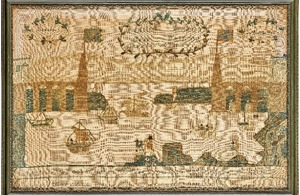19th century needlework of celebrated Menai Bridge at risk of leaving the UK
A temporary export bar has been placed on a needlework sampler of the Menai Bridge, Anglesey by a 19th century school girl

- The needlework has been valued at over £14,000
- Export bar is to allow time for a UK gallery or institution to acquire the needlework
An export bar has been placed on a needlework sampler showing the Menai Bridge, Anglesey, by 11 year old 19th century school girl, Mary Anne Hughes.
Designed by renowned engineer Thomas Telford, the Menai Bridge connects Anglesey to mainland Wales. Opening in 1826, it was the longest suspension bridge in the world at the time and cut the journey time to Holyhead, boosting travel and tourism to the area while benefiting local industries.
The needlework, which has been valued at £14,564, depicts the new bridge and boats crossing the Menai strait. It was stitched by local school girl Mary Anne Hughes in the 1800s to mark the opening of the suspension bridge.
Arts Minister Sir Chris Bryant said:
The opening of the Menai suspension bridge was a true feat of British engineering, which has had long lasting benefits to local heritage as well as boosting tourism and the North Wales economy.
Mary’s wonderful needlework reflects the importance of the bridge and is a telling reminder that every child, if given the right access to the arts, can contribute to the world around them.
I hope a UK buyer can be found so this artwork can be used to inspire children to embrace their creativity and love their local area.
Committee Member Mark Hallett said:
Mary Anne Hughes’s needlework picture of Menai Bridge in Anglesey, stitched when she was just 11 years old, is not only a testament to her individual skill and prodigious powers of concentration.
It is also a window into the world of early nineteenth century working class education and female accomplishment in Britain, giving us a glimpse of a culture that has been largely lost to us, and for which there are far too few traces.
This rare, modest treasure is of enduring interest and value, and thoroughly deserves to be saved for the nation.
The RCEWA Committee found the needlework met the first and third Waverley criteria for its outstanding connection with our history and national life and its outstanding significance to the study of social history within this area of Wales, and the importance of needlework within the education of young girls.
The decision on the export licence application for the sampler will be deferred for a period ending on 7 January 2025 inclusive. At the end of the first deferral period owners will have a consideration period of 15 Business Days to consider any offer(s) to purchase the sampler at the recommended price of £14,564 (inclusive of VAT of £594 which may be reclaimable by an eligible institution). The second deferral period will commence following the signing of an Option Agreement and will last for three months.
Notes to editors
-
Organisations or individuals interested in purchasing the carving should contact the RCEWA on 02072680534 or rcewa@artscouncil.org.uk.
-
Details of the sampler are as follows: A needlework picture of Thomas Telford’s suspension bridge across the Menai Straits, with a steamship and seven other marine craft, and figures walking in the foreground. Coloured silks on linen, 44 x 66 cm (framed). The embroidered script reads: ‘Anglesey / MENAI BRIDGE - Near Bangor - Caernavonshire / Caernarvon’ (within embroidered cartouches, above) ‘In legth [sic] 1714 Feet in Height 100 Feet from High Water Mark AD 1829 (Anglesey) / Mary Anne Hughes Her Work Aged 11 August 10th (Caernarvon)’ (in two rows across bottom).
-
Provenance: Previously owned by the Marquess of Anglesey and sold at Sotheby’s (11 April 2024, lot 82).
-
The Reviewing Committee on the Export of Works of Art and Objects of Cultural Interest is an independent body, serviced by Arts Council England (ACE), which advises the Secretary of State for Culture, Media and Sport on whether a cultural object, intended for export, is of national importance under specified criteria.